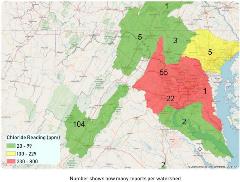Volunteers Find Dangerous Levels of Road Salt in Philadelphia-Area Streams
Urge Limited Salt Application Next Winter Using Best Practices
Gaithersburg, MD – With winter firmly in our rear-view, many of us are thinking warm thoughts about the start of summer. Unfortunately, Izaak Walton League volunteers found dangerous levels of road salt (sodium chloride) in Philadelphia-area streams that will affect water quality for many months to come.
The Izaak Walton League created Winter Salt Watch to give volunteers the tools to identify excess road salt in their community streams. The League distributed test kits to almost 500 volunteers this winter, and those volunteers documented salt levels in streams across 17 states. High levels of chloride were found in streams around eight metropolitan areas – not just occasional spikes but consistently high levels of chloride. How much is too much? Freshwater streams should have low to no salt content. Levels above 100 parts per million (ppm) are beyond what could be considered a naturally occurring concentration of salt, and above 230ppm is officially toxic. Salt Watchers found multiple hot spots for road salts around Philadelphia and its suburbs.
In Darby Creek, Pennypack Creek, Poquessing Creek, and other streams that drain into the Lower Delaware River – in areas including downtown Philadelphia, Berwyn, Havertown, Upper Darby, Southampton, Elkins Park, and Camden (NJ) – volunteers found that out of 55 chloride readings:
- 55% showed high levels of chloride (100-229 ppm)
- 31% were above the level deemed toxic (230 ppm+) by the Environmental Protection Agency (EPA)
Of the streams that flow into the Schuylkill River – an area that includes downtown Philadelphia, Ambler, Fort Washington, and Wynnewood – out of 29 chloride readings:
- 45% showed high levels of chloride (100-229 ppm)
- 10% were above the level deemed toxic (230 ppm+) by EPA
Volunteers for this effort included the Pennypack Streamkeepers, Tookany/Tacony-Frankford Watershed Partnership, Darby Creek Valley Association, River Watershed Initiative, Lower Merion Conservancy, Wissahickon Valley Watershed Association, Ambler Environmental Advisory Council Master watershed stewards, and local teachers.
Transportation departments apply road salt to highways and city streets to keep drivers safe. Communities spread salt on parking lots and sidewalks to keep our feet steady. Yet much of that salt washes into nearby streams, where it can create toxic conditions for fish and wildlife and corrode drinking water pipes, causing dangerous metals such as lead and copper to leach into water supplies. It can even cause health problems for people on low-sodium diets. Road salt is also absorbed into the ground, and with rain it leaches into streams and groundwater supplies, causing salt levels to spike months after the last snowfall. During dry summer months, the amount of salt in the water becomes concentrated, making it even more toxic for fish and wildlife.
Road salt contamination is a water quality issue that researchers and government agencies around the country are trying to understand and solve. Having site-specific data on chloride levels is the first step in advocating for best practices to protect drivers and clean water. These best practices include:
- Tailoring salt-application strategies based on the weather and the product being used
- Using calibrated salt spreaders on salt trucks and road temperature sensors
- Training and certification for snowplow drivers and contractors who maintain walkways, parking lots, and service roads
- Understanding how salt levels affect corrosion of drinking water pipes and how to prevent corrosion
###
Founded in 1922, the Izaak Walton League of America (www.iwla.org) protects America's outdoors through education, community-based conservation, and promoting outdoor recreation.
Read the Philadelphia Inquirer article based on this release.
Learn what you can do to take action on road salt in summer.
Salt Watchers across the Washington, DC, region also found multiple hot spots for road salts.
Among streams that flow into Catoctin Creek and the Potomac River – an area that includes Reston, Sterling, and Leesburg in Virginia and Bethesda, Gaithersburg, and Potomac in Maryland – volunteers found that out of 55 chloride readings:
includes Reston, Sterling, and Leesburg in Virginia and Bethesda, Gaithersburg, and Potomac in Maryland – volunteers found that out of 55 chloride readings:
- 16% showed high levels of chloride (100-229 ppm)
- 18% were above the level deemed toxic (230 ppm+) by the Environmental Protection Agency (EPA)
For streams that drain into the Anacostia, Occoquan, and Potomac Rivers – locations that include Washington, DC, as well as Silver Spring, College Park, and Landover in Maryland and Falls Church, Arlington, and Alexandria in Virginia – volunteers found that out of 22 chloride readings:
- 50% showed high levels of chloride (100-229 ppm)
- 5% were above the level deemed toxic (230 ppm+) by EPA
Volunteers included members of the Izaak Walton League, Neighbors of the Northwest Branch, Arlington Regional Master Naturalists and other master naturalists, local teachers, Audubon Naturalist Society volunteers, and Virginia Save Our Streams water quality monitors (including from the Reston Association and Goose Creek Association).
The Izaak Walton League is part of a Virginia Department of Environmental Quality effort to pilot a Salt Management Strategy (SaMS) in northern Virginia for smarter salt application, public awareness campaigns, and water quality monitoring of chloride levels in Accotink Creek – an effort that, if successful, could be applied throughout the region.